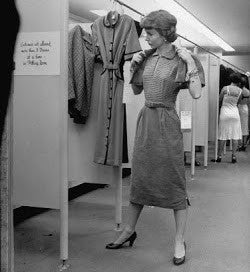
Retail Therapy (It's "Nothing New")
On Aug. 31, 2014, I watched the short BBC documentary, "The Secret Life of Your Clothes," about the impact our cast-off clothing is having on the culture, economy, and ecology of third-world countries. Not wanting any further part in the subjugation of the world's most vulnerable people or the potentially irreversible pollution of our planet, I decided to forgo all newly made, mass-produced garments for a year.
Could I do it? Could I resist the lure of the adorable, ridiculously cheap garment du jour at Target or on Pinterest?
About half my closet is costumes (both vintage and new). And I don't pay much attention to what's trendy, except to notice it's been done before. But like most people, I enjoy a cute, affordable, new thing, whether I "need" it or not.
Fashion industry profit and production has exploded in the new millennium. It's now a $3 trillion industry. What's changed most is how much of that money goes into production and how much goes directly into the pockets of corporate executives.
We used to buy clothes the way we bought refrigerators -- to last. Well-made everyday garments could be handed down, reworked to the current silhouette, and worn for decades. Today, we're encouraged to buy clothes the way we buy paper towels -- to use quickly and throw away. They're far cheaper, so we can have a lot more of them. They fall apart, so we have to replace them.
Until just a few decades ago, nearly all our garments were made right here in the U.S., under the watchful and protective eye of the ILGWU.
Now, although profits remain here, 97% of garment production is outsourced. To meet shareholder demand for rising profits and consumer demand for lower prices, "fast-fashion" requires its manufacturers to produce more for less. Factory bosses must cut corners.
With no labor unions, no OSHA oversight, and no environmental protection laws, that means ever-worsening conditions for the 40 million garment workers in third-world countries who produce clothing for western markets. Most are women and children, earning less than $3 per day.
In 2013, more than 1,100 people died and 2,500 were injured when the Rana Plaza garment factory collapsed in Bangladesh. Earlier that day, workers had been forced to return to the building after reporting cracks in the walls.
We watched the carnage on TV, briefly horrified. Very sad, yes, but these people are not like us and they're so far away. Our fleeting guilt is assuaged when we're told that this sort of tragedy is just part of the "development" process. In fact, low-wage work in appallingly dangerous conditions are their "least-worst option" and "a necessary step on the road to becoming a first-world country."
Really? Isn't it actually a choice we make with every purchase? When we buy a $10 dress at H&M or a $5 t-shirt at Old Navy, we are voicing our approval. We know we may only wear the thing a couple of times, but at that price, who can resist, right? And why should we?
In 2015 we will buy 80 billion pieces of new clothing. That's 400% more than we bought in 1995.
Producing and processing that staggering quantity of goods at ever-lower prices is having an unprecedented impact on the environment. Today, only the oil industry creates more pollution.
Birth defects, mental retardation, and cancers all directly linked to pesticides are exponentially higher in areas where heavily treated cotton is grown. People living downstream from leather processing plants where unregulated runoff contaminates the drinking water and soil suffer from skin and digestive disorders.
The average American now discards 82 pounds of clothing a year, adding a staggering 11 million tons of textile waste (most of it non-biodegradable) to landfills.
And giving your unwanted clothes to charity doesn’t help. It merely spreads the problem around. Just 10% of our donated clothes are sold in thrift shops. The rest arrive, by the ton, in enormous, shrink-wrapped parcels at the markets of poor Caribbean and African countries. Our endless stream of cast-offs, dubbed "dead white people's clothes" by locals, have generated an entire industry that is wreaking havoc on traditional manufacturing and threatening local cultures.
So, enough with the depressing statistics. Here's what happened during my year of "austerity." First of all, I spent some money. With a self-imposed ban on anything newly mass-produced, I gave myself free license to buy whatever vintage, antique, individually hand-made, and second-hand items I wanted. Here are a few of my acquisitions.




Not shown are the gorgeous 1920s tap pants, the original Civil War bonnet and 1910s dresses, and a knit jacket from the consignment store.
It really wasn't a very trying or difficult experience. In fact, I was tempted off the wagon only twice. First, with the arrival of the Garnet Hill clearance catalog, and second, oddly enough, with the Chadwick's of Boston catalog. Those old-fashioned, slightly frumpy clothes really appeal. I can't deny my traditionalism. But I can find the same thing, better made, in vintage versions. A 50s pencil skirt, or even a union-made 80s version, will always outdo and outlast a modern made-elsewhere version. Plus, it'll have a hem to work with. I resisted.
It's now Sept. 7, 2015, and the challenge is over. I still haven't bought anything new. I need to restock my underwear drawer, and since I tend to wear everyday lingerie until it's unwearable, I suppose I can go ahead and click "buy." Still, I hesitate. It takes 3 weeks to create a new habit, and I've had 53.
This experiment has definitely made me a more conscious and conscientious consumer. I'll never again say, "It's so cheap, it's silly not to buy it, even if I only wear it once." That's no longer the bargain it once seemed.
There's one question the original BBC documentary that inspired my plan, and the even more revealing "The True Cost" (which I watched more recently and highly recommend*), do not address. Namely, how does the production of insanely overpriced designer goods compare?
If I go to a high-end department store or boutique, and pay $175 for a pair of jeans or $75 for a t-shirt, where have all those extra dollars gone? Was it into advertising and merchandising, into the pocket of the designer or the corporation? Or did it go to the responsible production of the garment? I have my suspicions, and I'll need to do more research.

* Many of the statistics I've quoted come from this film. I've consulted various sources for corroboration.

Comments
I saw that same BBC documentary and it was horrifying, in all senses of the word. I’d already begun to cut back on cheap, mass produced clothes and this made me more determined to try and stick with well made clothing. Sadly vintage clothes are generally too small for me but I buy vintage repro and retro clothing, made in Britain (where I live) and I also make my own clothing when I have time to sit and sew. Like you I wear my underwear until it falls to pieces and therefore buy the best quality I can afford so that I don’t actually buy undies that often (which helps assuage my guilt that it is probably made in the third world – I haven’t found a Made In Britain underwear supplier which I can afford)
I live in hope that these things come in cycles and that it won’t be long before a significant number of people start to be concerned where their clothing comes from and change can start to happen. I could live with having fewer clothes, as our grandmothers did, but I’m not sure I could cope with wearing the same pair of knickers two days running as they did in the past!
Great blog, Liza. I could not agree with you more. The clothing business today certainly is not what it used to be. Sadly, it is not for the better.
I buy very little new- lingerie, tights and shoes. That’s about it. Mainly because I can’t bear the quality of new clothes today and the terrible cost to the people that make them.
My problem is how to dress my children is the most environmentally and humane way possible. How to find clothes that they like and that aren’t too expensive. My youngest does wear vintage and she quite likes it being a very girly girl but my sons are a different story. Any suggestions?
in her now old book, The End of Fashion, Terry Agins says that the high cost of high end mass produced clothes goes mainly into advertising.
Kudos to you for sticking to your goal, Liza! You’ve certainly earned some new undies.
I too had watched the BBC documentary and found it an eye opener. Thank you for your succinct take on it – a good reminder to be more conscientious when buying clothes.
Looking forward to reading what you discover about higher end fashions.
Great post, Liza. Fast fashion is the junk food of the clothing industry! And I’ve read in several places that 20-30% of what is in womens’ closets goes unworn! We are so enticed by sales, that we often buy without thinking, just because it’s a deal. But very often it ends up sitting in the closet. I agree, the time has come for all of us to put more thought into where the clothing we buy is made, and under what conditions.
Congratulations!
I have to admit, I’ve not ever wanted to buy cheap, fast fashion. I have never been able to afford to buy cheap. My conscience has never allowed me to do so, knowing where the items come from and how they are made. As I have become older with grandchildren in particular, my feelings have certainly remained firm. Can I imagine my grandchild working in conditions like these? My children? Your children? NO.
I have even become more diligent with the fabrics I purchase. Who I purchase them from. Where my notions come from.
It’s just not garments…it’s everything we buy and use everyday. I give a lot of thought to what I now purchase.
Vintage clothing is so exceptional in construction, fabric and wear. I look to Vintage first before I ever buy new.
Undergarments: I try to find items made in my own country and then in a country that I know is manufacturing them on site and not sending fabrics off to these terrible sewing mills. It can be done with a little research.
Thank you for blogging about a very important subject.
I really love your ‘voice’… I think it’s WONDERFUL to read a blog that is well-researched, politically pertinent and genuine. Thank you for the time you put into subjects with relevance and heart.
